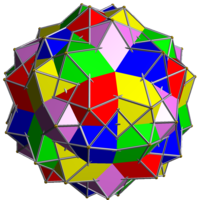Compound of five icosahedra
Appearance
| Compound of five icosahedra | |
|---|---|

| |
| Type | Uniform compound |
| Index | UC47 |
| Polyhedra | 5 icosahedra |
| Faces | 40+60 Triangles |
| Edges | 150 |
| Vertices | 60 |
| Symmetry group | icosahedral (Ih) |
| Subgroup restricting to one constituent | pyritohedral (Th) |

The compound of five icosahedra is uniform polyhedron compound. It's composed of 5 icosahedra, rotated around a common axis. It has icosahedral symmetry Ih.
The triangles in this compound decompose into two orbits under action of the symmetry group: 40 of the triangles lie in coplanar pairs in icosahedral planes, while the other 60 lie in unique planes.
Cartesian coordinates
[edit]Cartesian coordinates for the vertices of this compound are all the cyclic permutations of
- (0, ±2, ±2τ)
- (±τ−1, ±1, ±(1+τ2))
- (±τ, ±τ2, ±(2τ−1))
where τ = (1+√5)/2 is the golden ratio (sometimes written φ).
References
[edit]- Skilling, John (1976), "Uniform Compounds of Uniform Polyhedra", Mathematical Proceedings of the Cambridge Philosophical Society, 79 (3): 447–457, doi:10.1017/S0305004100052440, MR 0397554.
